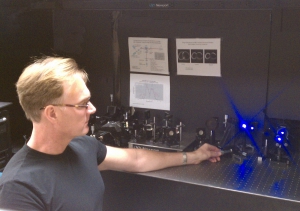
Application Areas--Photonics and Fiber Optics
Photonics & Fiber-Optics consulting for Telecommunications, Fiber-Optic Networks, Dense Wavelength Division Multiplexing (DWDM), Cellular Backhaul, High Frequency Trading (HFT), Research & Development (R&D), Homeland Security, Public Safety, and Government.
Services
• Photonics Consulting
• Optical Fiber Link Budgets
• Optical fiber measurements and characterization: polarization mode dispersion (PMD), chromatic dispersion (CD), OTDR, attenuation, power and rise-time budgets
• Experienced with most laser types from 300 nm to 10 μm, including Class IV: 20 Watt Argon, mode-locked Ti:Sapphire, Nd-YAG (neodymium-doped yttrium aluminum garnet), dye, CO2, HeNe, and laser diodes.
• Polarization state measurements, characterization, and modeling (Jones, Mueller, and Stokes matrices)
• Electro-optics (e.g., modulators, calculating the state of light/laser polarization from a crystal/semiconductor based on the known electro-optic tensor elements)
• Magneto-optics (e.g., optical Faraday effect, magnetic field sensors, isolators)
• Erbium Doped Fiber Amplifiers
• Second Harmonic Generation (SHG)
• Quantum entanglement, ghost imaging, and coincidence detection
• Photon counting
• Spontaneous down-conversion (SPDC) in non-linear crystals such as Beta-Barium Borate (β-Ba2BO4)
• Low latency fiber-optic link designs
• Optical sensors
• Optical Fiber Link Budgets
• Optical fiber measurements and characterization: polarization mode dispersion (PMD), chromatic dispersion (CD), OTDR, attenuation, power and rise-time budgets
• Experienced with most laser types from 300 nm to 10 μm, including Class IV: 20 Watt Argon, mode-locked Ti:Sapphire, Nd-YAG (neodymium-doped yttrium aluminum garnet), dye, CO2, HeNe, and laser diodes.
• Polarization state measurements, characterization, and modeling (Jones, Mueller, and Stokes matrices)
• Electro-optics (e.g., modulators, calculating the state of light/laser polarization from a crystal/semiconductor based on the known electro-optic tensor elements)
• Magneto-optics (e.g., optical Faraday effect, magnetic field sensors, isolators)
• Erbium Doped Fiber Amplifiers
• Second Harmonic Generation (SHG)
• Quantum entanglement, ghost imaging, and coincidence detection
• Photon counting
• Spontaneous down-conversion (SPDC) in non-linear crystals such as Beta-Barium Borate (β-Ba2BO4)
• Low latency fiber-optic link designs
• Optical sensors
Jeff’s graduate work focused on optical sensors and optical communications, and although his degree is in Electrical Engineering, a good fraction of his curriculum was in Physics. After graduating, he spent 10 years in the RF & Photonics Group of the Boeing Defense & Space Company, where he was lucky enough to work with a wide variety of lasers, electro-optics, photonics devices and instruments. Fortunately, RF is just longer on the wavelength scale compared with light so the basic physics is the same, and therefore it is not much of a stretch jumping between photonics and wireless.
